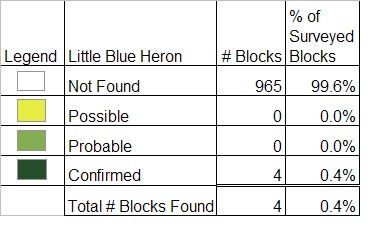Breeding Bird Atlases (BBA)
Find a Bird - BBA1
Breeding Bird Atlas 1 Species Accounts
Little Blue Heron
Egretta caerulea
Egg Dates
first week of May to fourth week of July
Number of Broods
one

Because the Little Blue Heron lacks fancy aigrettes, it was not subject to wholesale slaughter at the turn of the century; however, because it breeds in colonies with egrets, it nonetheless suffered considerable disturbance. It has been a fairly regular visitor to Massachusetts during the past century, sometimes in substantial numbers. The preponderance of white-plumaged juveniles in the late summer and fall suggests that many are postbreeding dispersal birds. Adults have been seen regularly in spring for the last 50 years, with the first confirmed breeding in 1940 in Marshfield. Little Blue Herons have nested regularly in small numbers in Massachusetts since the formation of large mixed-species heronries in the early 1970s. A maximum of 15 pairs was reported from House Island in Manchester during the mid-1970s, but that colony collapsed and disappeared by 1981. From one to five pairs have regularly nested at Clark’s Island in Plymouth Bay from 1975 to 1984 (Andrews 1990). In 1977, six pairs were reported breeding at Big Ram Island in Westport, and five pairs were located at Dead Neck/Sampsons Island in Osterville-Cotuit. It is difficult to census Little Blue Heron nests because the eggs and chicks closely resemble those of the Snowy Egret.
Little Blue Herons begin to arrive in Massachusetts in early April, when they can be observed foraging in coastal marshes, flooded grasslands, and freshwater ponds. The Little Blue Heron uses a wide variety of foraging behaviors, sometimes running actively, but more often walking slowly through shallow water or standing and peering straight down into the water. They often rake the bottom substrate with their feet, presumably to startle hidden prey. Sometimes they also capture prey flushed by other birds or animals. The diet of the Little Blue Heron is diverse, consisting of fish, frogs, insects, and other small animals.
In Massachusetts, Little Blue Herons typically begin nesting in early May. They are colonial breeders, sharing heronries with the much more common Snowy Egret. At Clark’s Island they have nested in Highbush Blueberry, Red Cedar, and probably Black Cherry. Breeding activities are highly ritualized. Males defend a territory around the nest and advertise primarily by an elaborate “stretch display” (Palmer 1962), bending the head backward and moving the body up and down in a pumping motion. Aggressive displays include the “upright display” with slightly erected crest and the “forward display” (Palmer 1962) with the feathers of the head, neck, and back raised. Harsh aarh calls accompany hostile interactions. The members of a pair have an elaborate series of calls and greeting ceremonies at the nest.
The nest, constructed of small sticks and twigs, is a loosely woven platform less than 3 feet in diameter. Males gather most of the nest materials and pass them to the females, which weave them into the nest. The eggs are a light bluish green, usually three to five in number. The three-week incubation period, shared by both parents, begins with the second egg. Hatching is asynchronous, resulting in a brood of chicks of varying size. Initially, food is regurgitated into the nest by the parent, but after about 5 days the young are fed directly from the adult’s bill. Juveniles clamber about the nest tree after about two weeks and can fly at a month old. They continue to be fed by the adults until they are six or seven weeks old.
Little Blue Herons have a pronounced postbreeding dispersal, during which time they are sometimes observed at inland sites. They migrate south in September and winter from the southern United States to South America.
Map Legend and Data Summary
Atlas 1 data collected from 1975-1979


Note: rare and local; associated with large coastal heronries
William E. Davis, Jr.



